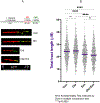Entinostat, a selective HDAC1/2 inhibitor, potentiates the effects of olaparib in homologous recombination proficient ovarian cancer
- PMID: 33867143
- PMCID: PMC8647995
- DOI: 10.1016/j.ygyno.2021.04.015
Entinostat, a selective HDAC1/2 inhibitor, potentiates the effects of olaparib in homologous recombination proficient ovarian cancer
Abstract
Objective: Poly ADP ribose polymerase inhibitors (PARPi) are most effective in BRCA1/2 mutated ovarian tumors. Better treatments are needed for homologous recombination HR-proficient cancer, including CCNE1 amplified subtypes. We have shown that histone deacetylase inhibitors (HDACi) sensitize HR-proficient ovarian cancer to PARPi. In this study, we provide complementary preclinical data for an investigator-initiated phase 1/2 clinical trial of the combination of olaparib and entinostat in recurrent, HR-proficient ovarian cancer.
Methods: We assessed the in vitro effects of the combination of olaparib and entinostat in SKOV-3, OVCAR-3 and primary cells derived from CCNE1 amplified high grade serous ovarian cancer (HGSOC) patients. We then tested the combination in a SKOV-3 xenograft model and in a patient-derived xenograft (PDX) model.
Results: Entinostat potentiates the effect of olaparib in reducing cell viability and clonogenicity of HR-proficient ovarian cancer cells. The combination reduces peritoneal metastases in a SKOV-3 xenograft model and prolongs survival in a CCNE1 amplified HR-proficient PDX model. Entinostat also enhances olaparib-induced DNA damage. Further, entinostat decreases BRCA1, a key HR repair protein, associated with decreased Ki-67, a proliferation marker, and increased cleaved PARP, a marker of apoptosis. Finally, entinostat perturbs replication fork progression, which increases genome instability.
Conclusion: Entinostat inhibits HR repair by reducing BRCA1 expression and stalling replication fork progression, leading to irreparable DNA damage and ultimate cell death. This work provides preclinical support for the clinical trial of the combination of olaparib and entinostat in HR-proficient ovarian cancer and suggests potential benefit even for CCNE1 amplified subtypes.
Keywords: Entinostat; Olaparib HR-proficient ovarian cancer.
Copyright © 2021. Published by Elsevier Inc.
Conflict of interest statement
Declaration of Competing Interest Dr. Khabele: Grant support from Astra-Zeneca and Deciphera, and speaker's Bureau for Astra Zeneca. Dr. Crispens: Grant support from Astra-Zeneca. Dr. Fuh: Grant support from Merck and is on advisory board of Genentech, Immunogen, GSK, Myriad and Aravive. Dr. Godwin: Co-founder of Sinochips Diagnostics and received support from Biovica and VITRAC Therapeutics, LLC. Remaining authors have no COI or disclosures.
Figures






Similar articles
-
The BET inhibitor INCB054329 reduces homologous recombination efficiency and augments PARP inhibitor activity in ovarian cancer.Gynecol Oncol. 2018 Jun;149(3):575-584. doi: 10.1016/j.ygyno.2018.03.049. Epub 2018 Mar 20. Gynecol Oncol. 2018. PMID: 29567272 Free PMC article.
-
Suberoylanilide hydroxamic acid (SAHA) enhances olaparib activity by targeting homologous recombination DNA repair in ovarian cancer.Gynecol Oncol. 2014 Jun;133(3):599-606. doi: 10.1016/j.ygyno.2014.03.007. Epub 2014 Mar 11. Gynecol Oncol. 2014. PMID: 24631446 Free PMC article.
-
Panobinostat sensitizes cyclin E high, homologous recombination-proficient ovarian cancer to olaparib.Gynecol Oncol. 2016 Oct;143(1):143-151. doi: 10.1016/j.ygyno.2016.07.088. Epub 2016 Jul 19. Gynecol Oncol. 2016. PMID: 27444036 Free PMC article.
-
Olaparib for the treatment of relapsed ovarian cancer with a BRCA1/2 mutation.Expert Rev Anticancer Ther. 2018 Oct;18(10):947-958. doi: 10.1080/14737140.2018.1510323. Epub 2018 Aug 24. Expert Rev Anticancer Ther. 2018. PMID: 30092674 Review.
-
Cediranib, a pan-VEGFR inhibitor, and olaparib, a PARP inhibitor, in combination therapy for high grade serous ovarian cancer.Expert Opin Investig Drugs. 2016;25(5):597-611. doi: 10.1517/13543784.2016.1156857. Epub 2016 Mar 16. Expert Opin Investig Drugs. 2016. PMID: 26899229 Review.
Cited by
-
Epigenetic Mechanisms and Therapeutic Targets in Chemoresistant High-Grade Serous Ovarian Cancer.Cancers (Basel). 2021 Nov 29;13(23):5993. doi: 10.3390/cancers13235993. Cancers (Basel). 2021. PMID: 34885103 Free PMC article. Review.
-
Class I HDAC inhibition reduces DNA damage repair capacity of MYC-amplified medulloblastoma cells.J Neurooncol. 2023 Sep;164(3):617-632. doi: 10.1007/s11060-023-04445-w. Epub 2023 Oct 3. J Neurooncol. 2023. PMID: 37783879 Free PMC article.
-
Homologous recombination proficient subtypes of high-grade serous ovarian cancer: treatment options for a poor prognosis group.Front Oncol. 2024 Jun 4;14:1387281. doi: 10.3389/fonc.2024.1387281. eCollection 2024. Front Oncol. 2024. PMID: 38894867 Free PMC article. Review.
-
Combination drug screen identifies synergistic drug interaction of BCL-XL and class I histone deacetylase inhibitors in MYC-amplified medulloblastoma cells.J Neurooncol. 2024 Jan;166(1):99-112. doi: 10.1007/s11060-023-04526-w. Epub 2024 Jan 7. J Neurooncol. 2024. PMID: 38184819 Free PMC article.
-
New and Effective Inhibitor of Class I HDACs, Eimbinostat, Reduces the Growth of Hematologic Cancer Cells and Triggers Apoptosis.Pharmaceutics. 2025 Mar 25;17(4):416. doi: 10.3390/pharmaceutics17040416. Pharmaceutics. 2025. PMID: 40284412 Free PMC article.
References
-
- Fuh K, Mullen M, Blachut B, Stover E, Konstantinopoulos P, Liu J, et al. Homologous recombination deficiency real-time clinical assays, ready or not? Gynecol Oncol 2020 - PubMed
-
- Pommier Y, O’Connor MJ, de Bono J. Laying a trap to kill cancer cells: PARP inhibitors and their mechanisms of action. Sci Transl Med 2016;8:362ps17 - PubMed
-
- Ledermann J, Harter P, Gourley C, Friedlander M, Vergote I, Rustin G, et al. Olaparib maintenance therapy in platinum-sensitive relapsed ovarian cancer. N Engl J Med 2012;366:1382–92 - PubMed
-
- Mirza MR, Pignata S, Ledermann JA. Latest clinical evidence and further development of PARP inhibitors in ovarian cancer. Ann Oncol 2018;29:1366–76 - PubMed
Publication types
MeSH terms
Substances
Grants and funding
LinkOut - more resources
Full Text Sources
Other Literature Sources
Medical
Miscellaneous

